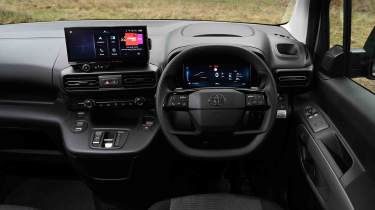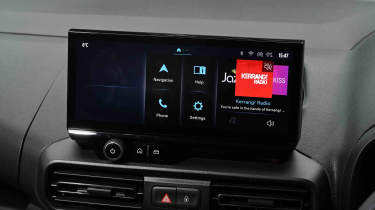We tested the updated Proace City Verso in seven-seat Icon trim in early March in cold conditions, and saw efficiency of 3.1 miles per kWh. This did include a variety of situations, including motorway work, but a projected range of 155 miles at that rate is well short of the official figures.
| Model | Battery size | Range | Insurance group |
| Proace City Verso Electric | 50kWh | 213 miles | 18-19 |
Insurance groups
The three versions of the Proace City Verso available at the time of writing fall into groups 18 and 19 for insurance, with the Design model and Icon Long both sitting in the higher group. Those ratings are actually a couple of groups lower than the mechanically identical Citroen Berlingo and Vauxhall Combo Life.
Tax
An electric van-based MPV is going to be a tempting company car for drivers with big families. Benefit-in-Kind (BiK) costs will be low, courtesy of the EV powertrain, while P11D prices are considerably lower than other seven-seat models that are available.
Road tax is charged at the standard rate of £195, with all versions coming in under the £40,000 luxury car tax threshold.
Depreciation
The Proace City Verso performs fairly well when it comes to how much it’ll be worth in three years’ time. A figure of 56 per cent for the seven-seat version is well ahead of the likes of the Citroen Berlingo and Peugeot Rifter, which have residuals in the low 40 per cent range. However, the Toyota can’t match the seven-seat Dacia Jogger, which is not only cheaper, but also has residuals of up to 68 per cent.
Van-based MPVs such as the Proace City Verso are the very epitome of form following function

| Pros |
|
| Cons |
|
A van-derived MPV is never going to set the world on fire with characterful design, and that’s the case with the Toyota Proace City Verso. While it shares tech with a number of other models, the design of the Verso’s front end means that from the leading edge of the bonnet forward, Toyota has been able to give the car a unique nose. A facelift at the end of 2024 introduced a smoother design that replaced the pointed grille that featured before, but this has made it more generic than ever. Combined with the black bumpers and plastic wheel trims of Icon models, as well as a neutral colour palette, the Proace City Verso easily blends into the background.
Interior and dashboard design
A sea of black plastic greets you inside the Proace City Verso, and the layout is identical to the Citroen Berlingo’s. While the electric model doesn’t need a gearlever, the drive toggle sits in the same spot that a shifter would, with a prominent extension sprouting from the middle of the dashboard. The layout is fairly open, though, so at least there’s a sense of space around you.
Materials and build quality
Those hard plastics feel as if they’ll stand up to the rigours of family life, while the fabric seat trim gives the impression of being hard-wearing, too. Everything is well put together, with no squeaks or rattles, while the switchgear is functional and fuss-free.

Infotainment, sat-nav and stereo
As well as outsourcing the Proace City Verso’s running gear, the infotainment is sourced from Stellantis, too. It’s most obvious from the menus on the 10-inch touchscreen, where the interface uses the same fonts and graphics as those found in its Peugeot and Citroen counterparts. The system is fine on the whole, although the standard-fit sat-nav looks basic, but it gets the job done. You can bypass this and use your smartphone, though, and the screen resolution is good enough for clear mapping.


